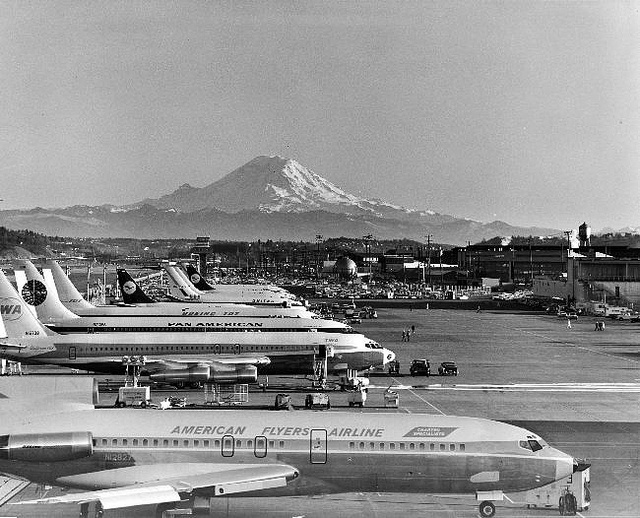
You’ve probably heard the news. A major international corporation is growing and needs a place to live. Some folks are eager. Some folks are anxious. Optimism and pessimism battle as cities and neighborhoods decide how to react to incredible growth. That’s Amazon’s situation now. It was also Boeing’s situation decades ago. As Boeing grew, so did Seattle, and especially the surrounding towns.
Even now, many people think Boeing’s headquarters are in Seattle. They moved to Chicago a few years ago, but the company did get its start along the Duwamish, just south of downtown. As for being actually in Seattle’s city limits, well, that’s a bit difficult.
The first Boeing airplanes didn’t take up much room. Floatplanes don’t need runways. They were built on land, floated out, and then flown from our bays and lakes. The company wasn’t very large because it didn’t need much land or employees.

World War II changed that dynamic. More traditional airplanes, particularly bombers like the B-17, required long runways and lots of room on all sides, just in case something went amiss. And things did go amiss. Another reason for housing to sit a bit farther back.
Housing wanted to get close, though. The production rates were phenomenal. Currently, Boeing proudly produces about one 737 every day, its most successful airliner. At the peak of wartime production, over a dozen B-17s were produced in the same time. That meant a lot of people, a lot of commuting, and a need for housing in places likes Georgetown, South Park, and Rainier Valley.

The work didn’t just happen at what came to be known as Boeing Field and Plant 2. Jump over the appropriately named Skyway, and find the new second home, Renton. Instead of chief exports of coal and lumber, an assembly plant and long runway became a major industrial and economic boost to the city at the south end of Lake Washington. On land that had been a drained swamp, a new facility was built that would produce yet another generation of flying boats. Waterfront property has advantages beyond just having a nice view. Eventually, the flying boat business was put aside and the next generation of bomber was built instead, the B-29. One handy feature, new airplanes could be test flown over water instead of over houses. Sleepy Renton woke up and growth climbed into the Renton Highlands.

The wars passed. Jets replaced props. They changed the industry, the way the world worked, and created jet-setters, but that didn’t mean much of a change for the towns. The same facilities worked fine. For a while.
The move to build the 747 was a big enough engineering challenge. Deciding where to build the place that would build the plane was just as tough. The runways had to be longer. The assembly plants would set new records for the size of buildings. Finding enough flat land around hilly Seattle wasn’t easy, especially when it also had to be close to highways and railroads so people and parts could arrive easily. Instead of a short hop between neighborhoods in King County, now Boeing’s influence would have a major impact in Snohomish County. Everett would boom, as would Lynnwood. Highways were extended and broadened. Seattle’s growth became the region’s growth.

Commutes for employees became a personal issue. Job transfers between the Duwamish and Renton sites didn’t require moving households. But, as Boeing added facilities farther south in Kent and Frederickson, and also north to Tulalip, employees could find a job shift meant buying and selling houses quickly. Some compromised by moving to Bellevue. Boeing didn’t have any assembly plants there, but thanks to I-405 and the bridges, a shift in jobs only meant a shift in commutes. None of the facilities were convenient, but many of them were relatively equally inconvenient.
By the time all of the plants were built and the neighborhoods developed, Boeing’s growth had impacted several counties and stretched out over almost a hundred miles.
Then, the company reached too far at just the wrong time. They’d gone bigger with the 747, and wanted to go faster with the Supersonic Transport. Through some bad timing with the economy, fuel prices, and technical challenges, the company found itself having to cancel the project and lay off cities worth of employees. At its peak there were 142,000 Boeing employees. Within a few years that dropped by 86,000. The indirect impact was far worse. So many people were leaving the area that someone created the famous sign, “Will the last person leaving Seattle turn out the lights?”

It took a while, but the company and the city and the region rebounded. Then, Boeing dominated the local economy. Now, the company is as successful as ever, and so is the rest of the region. Microsoft, Costco, Starbucks, Nordstrom, and many others mean the region is no longer reliant on any one company. Amazon rules! – at least for now. Amazon greatly impacts the region. Its influence is being felt in South Lake Union and throughout the urban core, but Boeing’s influence can easily be seen in the midcentury modern listings from south of Tacoma to north of Everett.

Amazon, et al are part of Seattle’s maturing years. Boeing was Seattle’s sometimes energetic, sometimes painful growth spurt, the region’s necessary and messy adolescence that enabled the rest.
